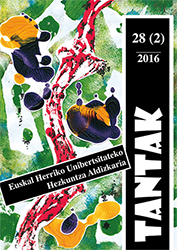Arte-hezkuntzaren kezkak eta arazoak gizarteko kultur entretenigarritasunetik haratago. Eskulturak baimentzen digun ikuskeraren ekarpena unibertsitateko irakaskuntzan
##plugins.themes.bootstrap3.article.main##
##plugins.themes.bootstrap3.article.sidebar##
Published
2017-05-23
Isusko Vivas Ziarrusta
Amaia Lekerikabeaskoa Gaztañaga
Abstract
If we start from the practice of art and experience in higher education in fine arts, specifically in the disciplinary field of sculpture, treat it as fundamental objective the possibility and channels of transmission of art. This happens once the curriculum Bologna in our context (Faculty of Fine Arts. UPV/EHU), reform that directly affects the perspective that time gives all learning based on the aesthetic experience from the practice of art introduced. As the body of content, we stopped on three main subjects: «Sculpture I», «Sculpture II» and «Sculpture, architecture and urban landscape». Subjects that share a similar methodology but manifests itself differently. This leads us to ask how point are effective current active methodologies and resources applied to education in the visual arts field of knowledge in which we can defend, as a hypothesis that the methods used in university system of artistic training provided they have been active.
##plugins.themes.bootstrap3.article.details##
Issue
Section
Papers

